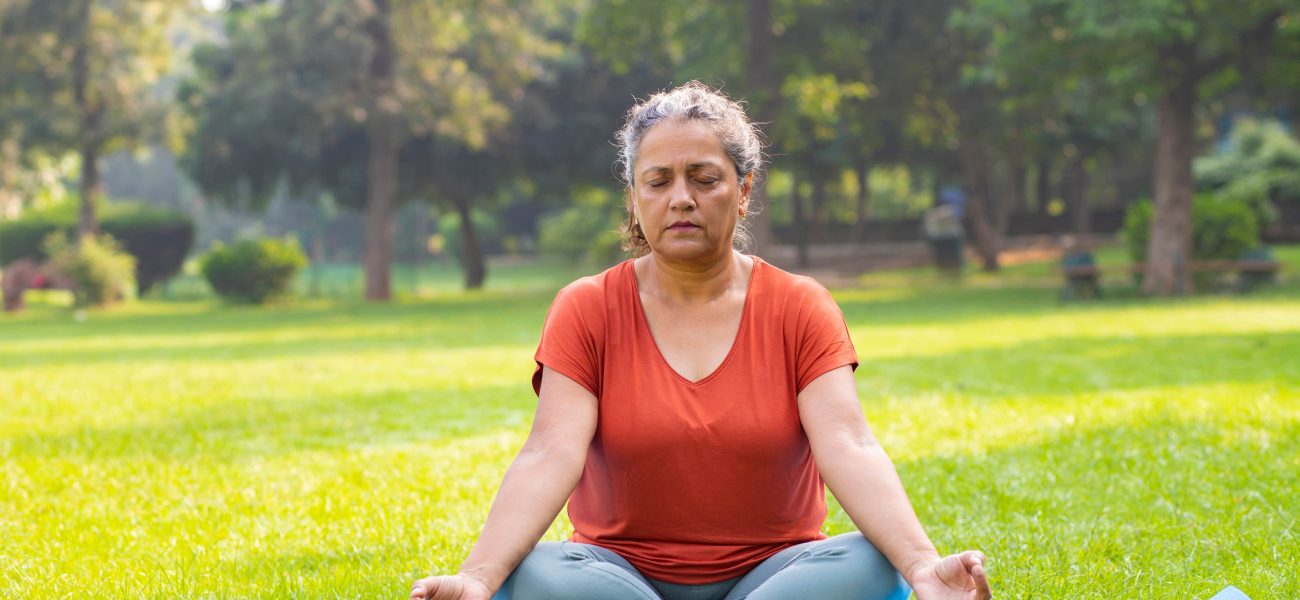Mindful Approaches to Manage Urinary Incontinence through Yoga and Meditation
Urinary incontinence, marked by involuntary bladder control loss, affects millions globally, impacting lives beyond mere physical discomfort. Its impact goes deeper, affecting the mind and spirit. Stress and anxiety, common emotional triggers, can worsen symptoms, emphasizing the need for a holistic approach.
The mind-body connection is vital in managing urinary incontinence. Mindfulness practices like meditation and deep breathing reduce stress, promote relaxation, and empower individuals to handle emotional stressors while enhancing bladder control.
Yoga & Meditation for Managing Urinary Leakage:
Yoga, an ancient holistic practice, blends postures, breath control, and meditation, promoting harmony between mind and body. It offers a practical toolkit for better bladder control, focusing on breath awareness.
- Strengthening Pelvic Floor Muscles: Yoga poses target these muscles crucial for bladder control, preventing involuntary leakage. Poses like Bridge, Cobra, and Kegel exercises help significantly.
- Improving Bladder Control: Yoga’s controlled breathing aids in relaxing bladder muscles, reducing urgency, and mitigating accident risks.
- Reducing Stress and Anxiety: Yoga and meditation reduce stress levels, improving bladder control. Stress and anxiety often worsen urinary incontinence symptoms.
- Enhancing Mind-Body Awareness: Both practices emphasize the mind-body connection. Heightened awareness enables proactive responses to bladder signals.
- Promoting Overall Well-Being: Beyond urinary incontinence, yoga and meditation contribute to overall health. Consistent practices lead to better long-term management.
These mindful practices strengthen muscles, improve bladder control, and reduce stress—common triggers for urinary leakage. For caregivers, encouraging loved ones to embrace this mindful journey offers both physical and emotional relief, fostering empowerment and confidence.
To those facing urinary incontinence, we invite you to integrate yoga and meditation into your management plan. They offer not only symptom relief but also a profound connection with yourself. These practices promise a better quality of life, reduced stress, and enhanced overall well-being.
Remember, the journey to managing urinary incontinence is unique for each individual. Consulting healthcare professionals is vital. Integrating yoga and meditation is a step toward greater control, peace, and a brighter tomorrow. With an open heart and mind, embark on this journey of self-discovery and healing, finding relief and empowerment along the way.
FAQ’s
2. How does yoga support incontinence management?
Yoga supports bladder control by strengthening the pelvic muscles and relaxing the body. Specific yoga poses improve the muscles that support the bladder. Yoga also helps reduce anxiety, which can make incontinence worse. When practiced daily, yoga builds core strength and improves body awareness, making it easier to recognize early urges and manage them calmly. Simple stretches, deep breathing, and slow movements help people feel more in control, both physically and mentally, over time.
3. Can beginners practice yoga for urinary incontinence?
Yes, beginners can practice yoga for incontinence. Start with easy poses that don’t strain the body. Basic stretches like Child’s Pose or Bridge Pose gently engage the pelvic area. It's important to focus on proper breathing and slow movements. Beginners should practice on a soft mat and avoid any posture that causes discomfort. Over time, these gentle exercises help strengthen the muscles that support bladder control. Consulting a yoga instructor who understands incontinence is also helpful.
4. What are some recommended yoga poses for bladder control?
Yoga poses like Bridge Pose (Setu Bandhasana), Reclined Bound Angle Pose, and Child’s Pose (Balasana) are good for bladder support. These postures focus on strengthening the lower abdomen and pelvic muscles. Deep breathing during poses improves focus and relaxation. Regular practice can reduce pressure on the bladder, improve posture, and ease the mind. Start slowly, hold each pose for a few seconds, and increase time as you gain strength and confidence. Always stay within comfort limits.
5. How does meditation help with urinary incontinence?
Meditation helps by calming the mind and lowering stress, which often makes bladder issues worse. When people feel anxious, they may feel the urge to urinate more often. Meditation teaches how to control such emotions. By sitting quietly and focusing on breathing, the brain learns to stay calm. Over time, this improves how the body reacts to bladder signals. It also improves sleep and focus, which supports healthy bladder habits. Daily meditation for even 10 minutes can help.
6. How often should one practice yoga and meditation for results?
For best results, practicing yoga and meditation at least 4–5 times a week is helpful. Even 20 to 30 minutes daily can make a difference. The key is consistency. With regular practice, body awareness and muscle control improve over time. Don’t expect quick changes; managing incontinence through mindfulness is a slow and steady process. Include breathing exercises and light yoga stretches daily. Meditation can also be done before sleep to reduce stress and improve bladder response overnight.
7. Can yoga and meditation fully cure urinary incontinence?
Yoga and meditation may not fully cure urinary incontinence, but they can help manage it better. These practices strengthen muscles, improve mental focus, and reduce stress. This helps reduce the number of times a person feels the urge to urinate. While they don’t replace medical treatment, they work well as supportive habits. People who practice regularly often feel more in control of their body and emotions. For best results, combine mindfulness with medical advice and healthy routines.
8. Is it safe for seniors to do yoga for incontinence?
Yes, yoga is generally safe for seniors, especially when done under guidance. Many yoga poses can be modified to fit a senior’s physical ability. Gentle postures help strengthen the pelvic and abdominal areas without causing strain. Seniors should use support like cushions, chairs, or walls if needed. It’s important to go slow and focus more on breathing and relaxation than on complex moves. With regular practice, seniors may see better bladder control and reduced discomfort.
9. Are there any breathing techniques to help control urgency?
Yes, breathing techniques like deep abdominal breathing and alternate nostril breathing can help manage urgency. When you feel the sudden urge to urinate, slow, deep breathing can help calm the mind and delay the response. These techniques work by relaxing the nervous system and reducing pressure on the bladder. Practicing deep breathing regularly also improves overall bladder awareness. Try 4-5 minutes of slow breathing each morning or before sleep for better control and relaxation.
10. What should people avoid while doing yoga for incontinence?
While doing yoga for incontinence, avoid postures that put too much pressure on the abdomen or strain the lower back. Do not hold your breath during poses, as it can increase pressure inside the body. Avoid fast-paced or hot yoga classes unless advised. Listen to your body—if a pose feels uncomfortable, skip it. Also, avoid pushing beyond your limit, especially if you're new to yoga or have other health concerns. Always consult a doctor or certified yoga trainer before starting.






















